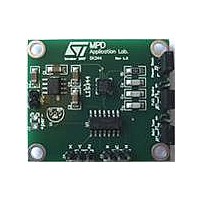STEVAL-MKI109V1 STMicroelectronics, STEVAL-MKI109V1 Datasheet - Page 17

STEVAL-MKI109V1
Manufacturer Part Number
STEVAL-MKI109V1
Description
MOTEHRBOARD MEMS ADAPTER STM32
Manufacturer
STMicroelectronics
Series
MEMSr
Specifications of STEVAL-MKI109V1
Main Purpose
Motherboard; Accelerometer, Gyroscope
Embedded
Yes, MCU, 32-Bit
Utilized Ic / Part
STM32 and MEMS Demo Boards
Primary Attributes
DIL24 Socket for ST MEMS Adapter Boards
Secondary Attributes
3 V on-board linear voltage regulator
Sensing Axis
Triple Axis
Operating Voltage
5 V
Operating Current
0.68 mA
Lead Free Status / RoHS Status
Lead free / RoHS Compliant
For Use With/related Products
LIS344ALH
Other names
497-10682
STM32F102x8, STM32F102xB
Description
Universal synchronous/asynchronous receiver transmitter (USART)
The available USART interfaces communicate at up to 2.25 Mbit/s. They provide hardware
management of the CTS and RTS signals, support IrDA SIR ENDEC, are ISO 7816
compliant and have LIN Master/Slave capability.
The USART interfaces can be served by the DMA controller.
Serial peripheral interface (SPI)
Two SPIs are able to communicate up to 12 Mbit/s in slave and master modes in full-duplex
and simplex communication modes. The 3-bit prescaler gives 8 master mode frequencies
and the frame is configurable to 8 bits or 16 bits. The hardware CRC generation/verification
supports basic SD Card/MMC modes.
Both SPIs can be served by the DMA controller.
Universal serial bus (USB)
The STM32F102xx medium-density USB access line embeds a USB device peripheral
compatible with the USB Full-speed 12 Mbs. The USB interface implements a full-speed (12
Mbit/s) function interface. It has software configurable endpoint setting and suspend/resume
support. The dedicated 48 MHz clock is generated from the internal main PLL (the clock
source must use a HSE crystal oscillator).
GPIOs (general-purpose inputs/outputs)
Each of the GPIO pins can be configured by software as output (push-pull or open-drain), as
input (with or without pull-up or pull-down) or as peripheral alternate function. Most of the
GPIO pins are shared with digital or analog alternate functions. All GPIOs are high current-
capable except for analog inputs.
The I/Os alternate function configuration can be locked if needed following a specific
sequence in order to avoid spurious writing to the I/Os registers.
ADC (analog to digital converter)
The 12-bit analog to digital converter has up to 16 external channels and performs
conversions in single-shot or scan modes. In scan mode, automatic conversion is performed
on a selected group of analog inputs.
The ADC can be served by the DMA controller.
An analog watchdog feature allows very precise monitoring of the converted voltage of one,
some or all selected channels. An interrupt is generated when the converted voltage is
outside the programmed thresholds.
Temperature sensor
The temperature sensor has to generate a a voltage that varies linearly with temperature.
The conversion range is between 2 V < V
< 3.6 V. The temperature sensor is internally
DDA
connected to the ADC_IN16 input channel which is used to convert the sensor output
voltage into a digital value.
Serial wire JTAG debug port (SWJ-DP)
The ARM SWJ-DP Interface is embedded. and is a combined JTAG and serial wire debug
port that enables either a serial wire debug or a JTAG probe to be connected to the target.
The JTAG TMS and TCK pins are shared respectively with SWDIO and SWCLK and a
specific sequence on the TMS pin is used to switch between JTAG-DP and SW-DP.
Doc ID 15056 Rev 3
17/69



















